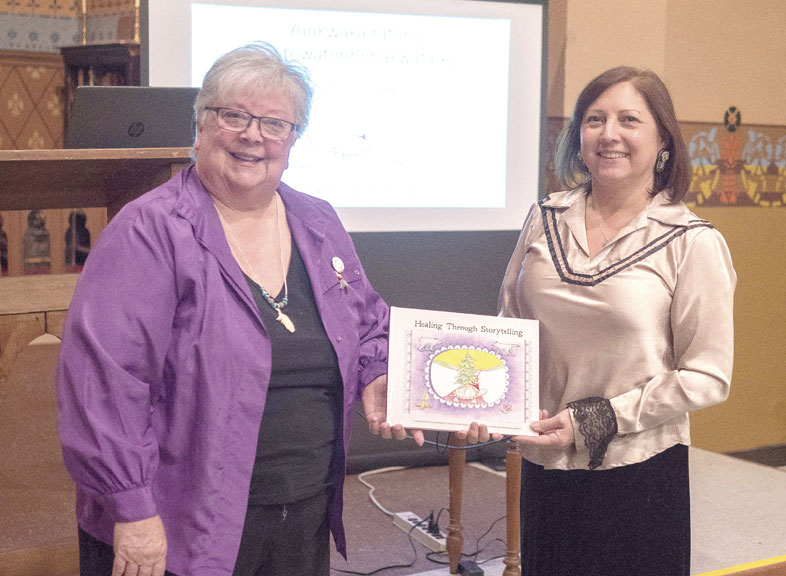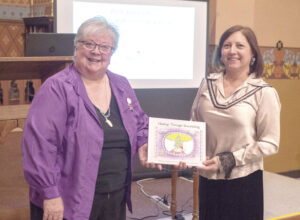County News
A journey towards healing

Families of residential school survivors tell their stories
Last Wednesday at Macaulay Church, Callie Hill, Executive Director of Tsi Tyónnheht Onkwawén:na (TTO) gave a presentation about a new book that tells the stories of families whose parents, grandparents or great-grandparents were sent to residential schools. In the period between 1862 and 1962, more than 130 children from Tyendinaga were sent to residential schools in either Brantford or Sault. Ste. Marie. The book, Healing Through Storytelling: Commemorating Residential School Survivors of Kenhtè:ke, Their Families and Descendants, collected the stories of 10 community members, and is intended to raise awareness and understanding to the broader public of the impact the residential school system continues to have on families. Ten community members who are descendants of the children who were sent to residential schools were invited to share their stories over a number of weekend workshops. The workshops were led by professional from the community and participants asked to write about their experiences and to create artworks in mixed media. The stories and art were incorporated into the new book. “The purpose for us is really towards healing,” said Hill. “There are a lot of books and resources out there on residential schools and the atrocities that happened at them, and a lot of people are familiar with them. We wanted to take it a step further and help our survivors and their families heal from those intergenerational traumas.” There are only a few residential school survivors left in Tyendinaga, and the trauma is still acutely present. One of these survivors did not wish to be included in the book. Other families were happy to tell their stories and work towards healing. The book contains stories and artworks, as well as a condolence ceremony to help people heal. It is written mostly in English with some sections written in Kanyen’kèha (Mohawk) with English translation. There is also a version of the Ohèn:ton Karihwatéhkwen (The Words That Come Before All Else), which is a thanksgiving address that is said at the start of any gathering of people. The book is intended to be used as an educational resource in the community, both in the school as well as in the planned language and cultural centre. This latter facility will extend the language education to Grade Six, as well as having an adult program. There are no first language speakers of Kanyen’kèha in the Tyendinaga community, and there are very few knowledge holders, so members from sister Mohawk communities are often asked to bring their expertise. The loss of knowledge and culture is among the lasting legacies of the residential school system.

(L-R): Narda Julg, who did the cover illustration, is seen here with Callie Hill, executive director of the cultural centre in Tyendinaga.
The book’s cover art was designed by Narda Kathaleen Julg, who also shared some of her story last Wednesday. Her mother spent six years at a residential school, and while there her family could not afford to bring her back home for the holidays. When her parents finally came to get her after six years, one of the teachers had to bring them together, because neither parents nor child could recognize each other. Narda’s mother told about her residential school experience only much later in life.
She remembers being constantly hungry, and being fed little more than porridge or gruel at meals. On one occasion, she and a few other girls went on a nighttime raid of the kitchen, hoping to find something to eat—they knew there was better food around because they could smell the aromas from the teachers’ dining room. They could only find bread, so they ate as much of that as they could. She also told of children being locked in a closet for speaking Mohawk. Narda said she originally envisioned a dark-themed cover, to reflect her mother’s stories, but changed her approach after speaking to Callie Hill, who wanted a cover that expressed light and life. She ended up drawing in coloured pencil “because that is what a child would use”, and the design was the tree of life upon the back of a turtle, representing Turtle Island. The three Mohawk clans (bear, wolf and turtle) are represented in three of the corners. Narda was wondering what to put in the fourth corner when news came of the discovery of unmarked graves at a Kamloops residential school site. The fourth corner now has a drawing of a pair of broken children’s shoes, to remember all the children who did not make it back home. Narda was grateful to have her stories incorporated into the book. “Any time you get to express not only something in your family but also in your culture, it increases your knowledge,” she said. “Every little bit of information to the general public is important if it opens eyes or raises questions so that people can begin to see what happened through all those years.”

The BLM people, the Idle No More people, and students of colonialism are finally bringing the sacred truth that has been hidden for generations, to this County and country.
Many residents have been shocked by the horribly repugnant truth that no one wants to hear, because white journalists, editors, historians, and academics have kept Canadians in the dark, by hiding the countless crimes against indigenous children and their communities.
The Canadian press aided and abetted Supremacist governments by creating false veneers of legitimacy for the state of Canada, even as Supremacists denied and trampled the human rights of generations of indigenous children, and their communities.
The white press shares the guilty of national child abuse, as it concealed crimes against humanity in the Residential Schools where Christian missionaries terrorized small children with: an enemy god that forced into their hearts and minds, daily starvation, beatings, exposure, isolation and humiliation, in order to gain control over their land wealth.
Ethical Canadians are rising up to hold all of them to account for their evil mistreatment of Canadians.